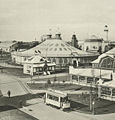- All-Russia Exhibition 1896
-
The All-Russia industrial and art exhibition 1896 in Nizhny Novgorod was held from May 28 (June 9) till October 1 (13), 1896. The 1896 exhibition was the biggest pre-revolution exhibition in Russian Empire and was organized with the money allotted by Nicholas II, Emperor of Russia. The All-Russia industrial conference was held together with the exhibition. The exhibition demonstrated the best achievements of the industrial development in Russia that began in the latter part of the 19th century:
- the world’s first radio receiver (thunderstorm register) designed by A. S. Popov;
- the first Russian automobile designed by Evgeniy Yakovlev and Pyotr Freze;
- the world’s first hyperboloid steel tower-shell and the world’s first steel lattice hanging and arch-like overhead covers-shells (8 exhibition pavilions with the total area of more than 25 thousand square meters, including the unique rotunda of V. G. Shukhov (Russian Empire patents №№ 1894, 1895, 1896 dated March 12, 1899);
- many other technical inventions, technologies and artistic achievements.
The suburb of Kanavino, on the left bank of Oka River, was chosen as the place for the exhibition. It occupied the territory of around 84 hectares within a few hundreds meters southwest of the Nizhny Novgorod Fair. Nearly 70 buildings and constructions were built in Nizhny Novgorod and at the exhibition with the money allotted by the Nicholas II Emperor of Russia. Also, more than 120 pavilions of private companies were built on the territory of the exhibition.
See also
- Alexander Stepanovich Popov
- Invention of radio
- Vladimir Grigorievich Shukhov
- Hyperboloid structure
- The world's first Hyperboloid structure
- Shukhov Rotunda
- Tensile architecture
- Steel lattice shell structure
- Expo (exhibition)
References
- Photos of Shukhov's Towers
- Rotonda of the Panrussian Exposition (1896) at Structurae
- http://www.tec21.ch/pdf/tec21_4120041723.pdf
- "The Nijni-Novgorod exhibition: Water tower, room under construction, springing of 91 feet span", "The Engineer", № 19.3.1897, P.292-294, London, 1897.
- William Craft Brumfield, "The Origins of Modernism in Russian Architecture", University of California Press, 1991, ISBN 0-520-06929-3.
- Rainer Graefe, Jos Tomlow, “Vladimir G. Suchov 1853-1939. Die Kunst der sparsamen Konstruktion.”, 192 S., Deutsche Verlags-Anstalt, Stuttgart, 1990, ISBN 3-421-02984-9.
Photos
-
Rotunda by V.Shukhov, Nizhny Novgorod, 1896
-
Shukhov Rotunda and rectangular pavilion, Nizhny Novgorod, 1896
-
Oval pavilion by V.Shukhov, Nizhny Novgorod, 1896
Categories:- Exhibitions in Russia
- History of radio
- Tensile architecture
- Lattice shell structures by Vladimir Shukhov
- Roof structures by Vladimir Shukhov
- Nizhny Novgorod
- 1896 in Russia
Wikimedia Foundation. 2010.





